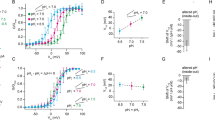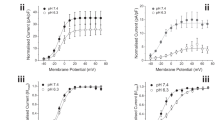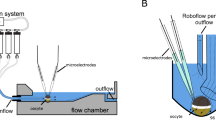Abstract
USING the double sucrose gap method, Bülbring and Tomita2 have shown that adrenaline hyperpolarises the membrane and reduces the electrotonic potential produced by constant current pulses in the guinea pig taenia coli muscle. They concluded, from the effects of membrane polarisation and changing external ionic composition on the adrenaline action, that an increase in the K and Cl conductances of the membrane is responsible for the hyperpolarisation.
This is a preview of subscription content, access via your institution
Access options
Subscribe to this journal
Receive 51 print issues and online access
$199.00 per year
only $3.90 per issue
Buy this article
- Purchase on Springer Link
- Instant access to full article PDF
Prices may be subject to local taxes which are calculated during checkout
Similar content being viewed by others
References
Abe, Y., and Tomita, T., J. Physiol., Lond., 196, 87–100 (1968).
Bülbring, E., and Tomita, T., Proc. R. Soc. Lond., B 172, 89–102 (1969).
Tomita, T., J. Physiol., Lond., 183, 450–468 (1966).
Inomata, H., and Kao, C. Y., J. Physiol., Lond., 226, 53–54P (1972).
Jenkinson, D. H., and Morton, I. K. M., J. Physiol., Lond., 188, 373–386 (1967).
Author information
Authors and Affiliations
Rights and permissions
About this article
Cite this article
TOMITA, T., SAKAMOTO, Y. & OHBA, M. Conductance increase by adrenaline in guinea pig taenia coli studied with voltage clamp method. Nature 250, 432–433 (1974). https://doi.org/10.1038/250432a0
Received:
Issue Date:
DOI: https://doi.org/10.1038/250432a0
This article is cited by
-
Aminergic neurons: State control and plasticity in three model systems
Cellular and Molecular Neurobiology (1981)
-
Increase in membrane conductance by adrenaline in parotid acinar cells
Experientia (1976)
Comments
By submitting a comment you agree to abide by our Terms and Community Guidelines. If you find something abusive or that does not comply with our terms or guidelines please flag it as inappropriate.



